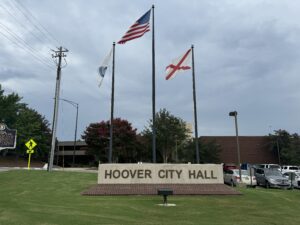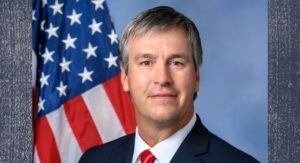12 killed, suspected gunman dead in mass shooting at California bar
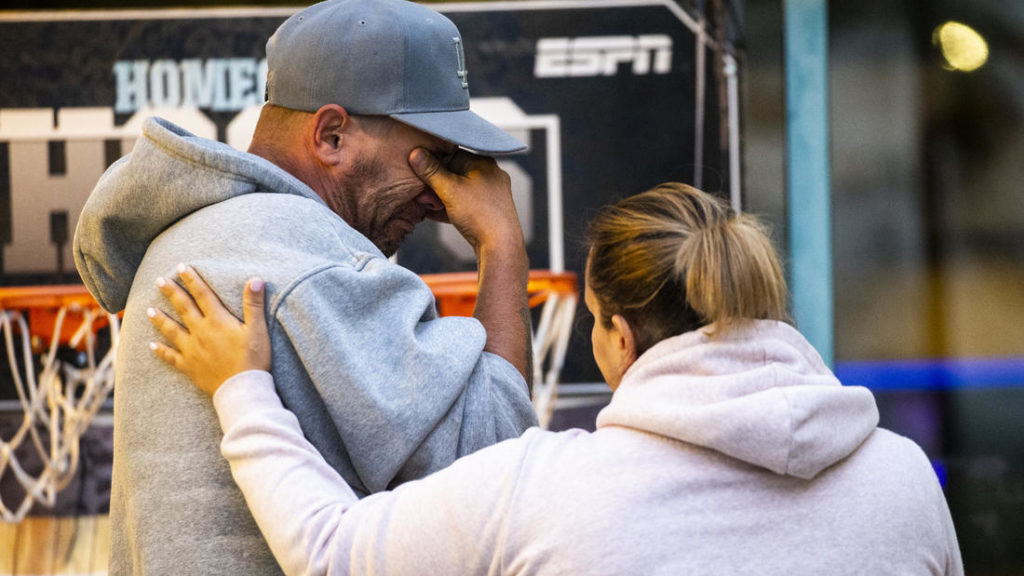
Using a smoke bomb and a handgun, a hooded Marine combat veteran dressed all in black opened fire during college night at a country music bar in Southern California, killing 12 people and sending hundreds fleeing in panic before apparently taking his own life, authorities said Thursday. Authorities said the motive for the attack Wednesday night was under investigation. The killer was identified as 28-year-old Ian David Long, a former machine gunner and veteran of the war in Afghanistan who was interviewed by police at his home last spring after an episode of agitated behavior that they were told might be post-traumatic stress disorder.Screaming in fear, patrons rushed for the exits, ducked under tables and hurled barstools to smash second-floor windows and jump to safety as gunfire erupted at the Borderline Bar & Grill, a hangout popular with students from nearby California Lutheran University. “I dropped to the floor,” Sarah Rose DeSon told ABC’s “Good Morning America.” ”A friend yelled, ‘Everybody down!’ We were hiding behind tables trying to keep ourselves covered.” The dead included 11 people inside the bar and a veteran sheriff’s sergeant who was the first officer inside the door, Ventura County Sheriff Geoff Dean said. “It’s a horrific scene in there,” Dean said in the parking lot. “There’s blood everywhere.” Anxious family members gathered at a teen center in town to await word on the fate of loved ones who had gone to the club. Jason Coffman received confirmation that his son Cody, 22, who was about to join the Army, was dead. Coffman broke down as he told reporters how his last words to his son were not to drink and drive and that he loved him. “Oh, Cody, I love you, son,” Coffman sobbed. The bloodshed was the latest in what seems to be a never-ending string of mass shootings that are happening with terrifying frequency across the United States. It was the nation’s deadliest such attack since 17 students and teachers were killed at a Parkland, Florida, high school nine months ago. It also came less than two weeks after a gunman massacred 11 people at a synagogue in Pittsburgh. President Donald Trump praised police for their “great bravery” in the California attack and said, “God bless all of the victims and families of the victims.” He ordered flags flown at half-staff in honor of the victims. I have been fully briefed on the terrible shooting in California. Law Enforcement and First Responders, together with the FBI, are on scene. 13 people, at this time, have been reported dead. Likewise, the shooter is dead, along with the first police officer to enter the bar…. — Donald J. Trump (@realDonaldTrump) November 8, 2018 ….Great bravery shown by police. California Highway Patrol was on scene within 3 minutes, with first officer to enter shot numerous times. That Sheriff’s Sergeant died in the hospital. God bless all of the victims and families of the victims. Thank you to Law Enforcement. — Donald J. Trump (@realDonaldTrump) November 8, 2018 Long was armed with a Glock 21, a .45-caliber designed to hold 10 rounds plus one in the chamber, according to the sheriff. But it had an extended magazine — one capable of holding more ammunition — that is illegal in California, Dean said. The killer also deployed a smoke device, a law enforcement official told The Associated Press. The official was not authorized to discuss the investigation publicly and spoke on condition of anonymity. Authorities converged on Long’s home in Newbury Park, about 5 miles from the Borderline bar, in a search for clues to what set him off. “There’s no indication that he targeted the employees. We haven’t found any correlation,” the sheriff said. “Maybe there was a motive for this particular night, but we have no information leading to that at all.” Long was in the Marines from 2008 to 2013, rose to the rank of corporal and served in Afghanistan in 2010-11, the military said. Authorities said he had no criminal record, but Dean said officers were called to his home in April, when deputies found him angry and acting irrationally. The sheriff said officers were told he might have PTSD because of his military service. A mental health specialist met with him and didn’t feel he needed to be hospitalized. Tom Hanson, 70, who lives next door to Long and his mother, said Wednesday that he called the police about six months ago when he heard “heavy-duty banging” and shouting coming from the Longs’ home. “I was concerned because I knew he had been in the military,” he said. Hanson said the sheriff’s deputy who arrived took his information, but he never learned more about what happened and hadn’t spoken to Long since then. He said he was “dumbfounded” by the bloodshed. The gunman was tall and wearing all black with a hood and his face partly covered, witnesses told TV stations. He first shot a security guard standing outside, then went in and opened fire on staff members and patrons, the sheriff said. Sheriff’s Sgt. Ron Helus and a passing highway patrolman arrived at the Borderline around 11:20 p.m. in response to several 911 calls, heard gunfire and went inside, the sheriff said. Helus was immediately shot repeatedly, Dean said. The highway patrolman pulled Helus out, then waited as a SWAT team and scores more officers arrived. Helus died early Thursday at a hospital. By the time officers entered the bar again, the gunfire had stopped, according to the sheriff. They found 12 people dead inside, including the gunman, who was discovered in office and had apparently shot himself, the sheriff said. “There’s no doubt that they saved lives by going in there and engaging with the suspect,” said Dean, who was set to retire on Friday. He praised the slain officer — a close friend — as a hero: “He went in there to save people and paid the ultimate price.” In addition to the dead, one other person was
Latino voters seek to challenge Alabama Census lawsuit

Latino voters and civil-rights groups have asked to join a lawsuit to defend the practice of including people in the country illegally in U.S. Census counts. The counts are used to configure congressional seats. Alabama and Congressman Mo Brooks sued the Census Bureau and the U.S. Commerce Department in May, arguing the predicted 2020 Census numbers will cause the state to lose a congressional seat and an electoral vote to a state with a “larger illegal alien population.” It has been a longstanding practice to include all U.S. residents, including noncitizens regardless of immigration status, in the census, which also determines the number of congressional seats for each state. In 2016, the U.S. Supreme Court ruled against two Texas residents who argued their votes were diluted by the practice of using the “whole population” to draw legislative district lines. Alabama is seeking to have the practice declared unconstitutional. The state argues it violates existing statutes that “require a census enumeration of the total of legally present resident population.” The Mexican American Legal Defense and Educational Fund filed a motion on Thursday on behalf of six voters and the group Chicanos Por La Causa, which are seeking to join the case as defendants. They say they live in states, including California, Florida, Texas, and Arizona, that could lose congressional seats and federal funding if the count doesn’t include all residents. They fear the federal government will not fight for their interests in the case because it has “no specific incentive to defend the use of a particular population base” when it comes to configuring congressional seats. Instead, the motion says, the government’s stake is limited to defending the criteria and procedures used by the Census Bureau. The federal government is charged with “representing varied public and administrative interests,” the motion says. The voters and civil rights groups, on the other hand, are interested in protecting “their private interests in political access and representation” and the apportionment standard that is currently in place. Republished with the permission of the Associated Press.
Trump administration to rescind Obama-era guidance on affirmative action
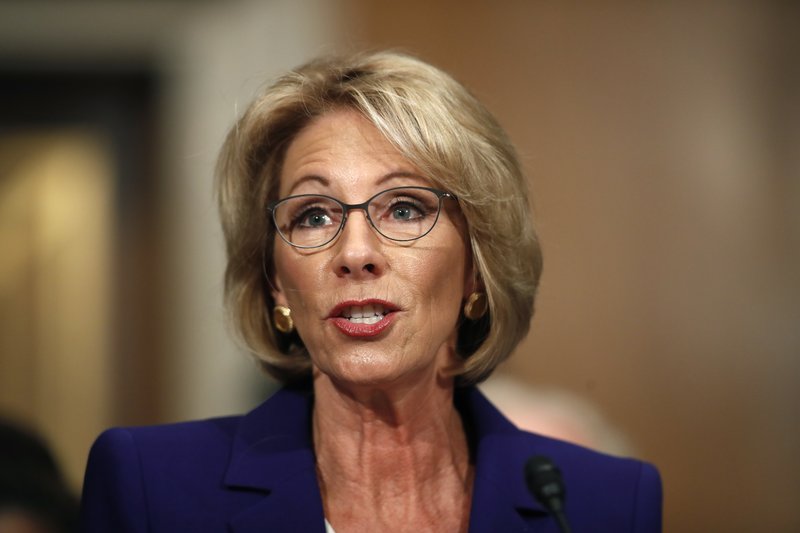
The Trump administration is rescinding Obama-era guidance that encouraged schools to take a student’s race into account to encourage diversity in admissions, a U.S. official said Tuesday. The shift would give schools and universities the federal government’s blessing to take a race-neutral approach to the students they consider for admission. Such guidance does not have the force of law, but schools could use it to help defend themselves against lawsuits over their admission policies. The action comes amid Supreme Court turnover expected to produce a more critical eye toward schools’ affirmative action policies. The high court’s most recent significant ruling on the subject bolstered colleges’ use of race among many factors in the college admission process. But the opinion’s author, Anthony Kennedy, announced his resignation last week, giving President Donald Trump a chance to replace him with a justice who will be more reliably skeptical of affirmative action. A formal announcement was expected later Tuesday from the Justice and Education departments, according to the official, who spoke on condition of anonymity because the official was not authorized to speak on the record. The guidance from the Obama administration gave schools a framework for “considering race to further the compelling interests in achieving diversity and avoiding racial isolation.” In a 2011 policy document, the administration said schools have a “compelling interest” in ensuring a diverse student body, and that while race should not be the primary factor in an admission decision, schools could lawfully consider it in the interest of achieving diversity. “Institutions are not required to implement race-neutral approaches if, in their judgment, the approaches would be unworkable,” the guidance said. “In some cases, race-neutral approaches will be unworkable because they will be ineffective to achieve the diversity the institution seeks.” The administration issued a similar guidance document in 2016 aimed at giving schools a framework for “considering race to further the compelling interests in achieving diversity and avoiding racial isolation.” The Obama approach replaced Bush-era policy from a decade earlier that discouraged affirmative action programs and instead encouraged the use of race-neutral alternatives, like percentage plans and economic diversity programs. The Trump administration signaled Tuesday that it planned to reinstate the Bush administration’s philosophy. Civil liberties groups immediately decried the move, saying it went against decades of court rulings that permit colleges and universities to take race into account. “We condemn the Department of Education’s politically motivated attack on affirmative action and deliberate attempt to discourage colleges and universities from pursuing racial diversity at our nation’s colleges and universities,” Kristen Clarke, president and executive director of the Lawyers’ Committee for Civil Rights Under Law, said in a statement. In 2016, the Supreme Court, in an opinion written by Kennedy, granted affirmative action policies a narrow victory by permitting race to be among the factors considered in the college admission process. Kennedy wrote that the University of Texas’ admission plan was in line with past court decisions that allowed for the consideration of race to promote diversity on college campuses. The ruling bitterly disappointed conservatives who thought that Kennedy would be part of a Supreme Court majority to outlaw affirmative action in education. Justice Antonin Scalia died after the court heard arguments in the case but before the decision was handed down. Eight states already prohibit the use of race in public college admissions: Arizona, California, Florida, Michigan, Nebraska, New Hampshire, Oklahoma and Washington. The Wall Street Journal first reported the move. Republished with the permission of the Associated Press.
On Long Island, Donald Trump to speak on immigration, gang violence

President Donald Trump will hold a roundtable discussion on Long Island on illegal immigration and gang violence that the White House is calling a “national call to action for legislative policy changes.” White House spokesman Hogan Gidley says the discussion with law enforcement and local leaders will focus on “immigration loopholes” that he said allows the violent MS-13 gang “to infiltrate our communities.” MS-13 has been blamed for some two dozen killings on Long Island the past two years. Trump has used the violence to bolster the urgency of his push to overhaul the nation’s immigration laws, as well as the need to build a border wall with Mexico and enact tougher travel restrictions. He’s also argued for loosening restrictions on law enforcement, encouraging police officers whom he calls “rough guys.” “Please don’t be too nice,” he told law enforcement officials in a similar trip he made to Long Island last July. Trump will also attend a fundraiser in his hometown of New York City on Wednesday evening. The 75-person dinner is expected to raise $5 million for the Republican National Committee and the president’s re-election campaign, the RNC said. Last week, Trump used the word “animals” to describe some people who enter the country illegally, in response to a comment about MS-13. The president says he will continue to use the term in referring to the gang. The White House also released a fact sheet Monday morning titled “WHAT YOU NEED TO KNOW ABOUT THE VIOLENT ANIMALS OF MS-13.” MS-13, or the Mara Salvatrucha, is believed by federal prosecutors to have thousands of members across the U.S., primarily emigrants from Central America. It has a stronghold in Los Angeles, where it emerged in the 1980s as a neighborhood street gang, but it also has wreaked violence in cities and suburbs across the U.S., including Long Island. The president has called for an end to “catch-and-release” policies, which generally refers to the release of unauthorized immigrants while they await immigration hearings instead of keeping them in custody as well as changes ro rules governing minors and asylum seekers. Gidley claims the policies “allow hundreds of thousands of illegal and unauthorized aliens to gain entry and release in the United States” and says they can be exploited by violent gangs, cartels, and drug dealers. Many teenagers on Long Island have been held on gang accusations, swept up in various federal investigations. But Immigration advocates say some teenagers arrested in the crackdowns in New York and California have been unfairly tied to gangs and wrongly held at detention centers. Republished with the permission of the Associated Press.
California county considers fighting state’s ‘sanctuary’ law
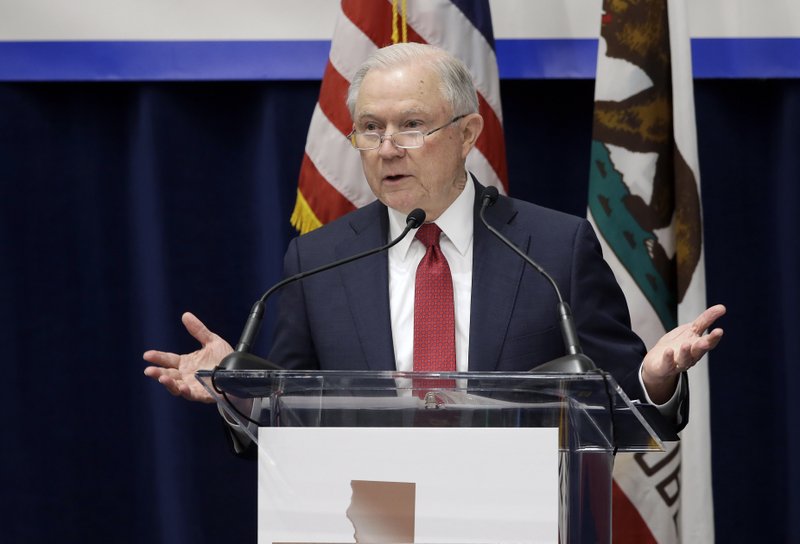
Leaders of Orange County, California, planned Tuesday to consider fighting a state law aimed at protecting immigrants from stepped-up deportations under the Trump administration. The backlash to the state’s so-called sanctuary law comes a week after the small city of Los Alamitos in Orange County voted to opt out of the policy. The all-Republican supervisors of the Southern California county of 3.2 million people were expected to discuss passing a resolution in support of Los Alamitos and whether to join the U.S. government’s lawsuit over the law, which bars police in many cases from turning over suspects to federal immigration agents for deportation. “This legislation prevents law enforcement from removing criminals from our community and is a threat to public safety,” said Supervisor Shawn Nelson, who has proposed joining the lawsuit by President Donald Trump’s administration or filing a new one. Orange County, which is home to Disneyland and wealthy beach communities where many people vacation, has a five-member board of supervisors, and all are Republican. While Republicans still outnumber Democrats in the county, Democrats have gained significant ground in recent years, and Hillary Clinton won more votes than Trump in Orange County in the 2016 presidential election. California, a liberal state that is home to more than 10 million immigrants, passed its sanctuary law last year to limit local police collaboration with U.S. immigration authorities. Supporters argue that the measure would encourage immigrants to report crime without fearing deportation, while critics say local police should provide more assistance to federal authorities. Officials in Los Alamitos, a community of about 12,000 people 20 miles (32 kilometers) southeast of downtown Los Angeles, raised constitutional concerns about the law and sent letters to other cities seeking their support. Legal experts and immigrant advocates have said cities can’t simply opt out of state law and will face lawsuits if they try. Sameer Ahmed, a staff attorney at the American Civil Liberties Union of Southern California, said some cities appear to be discussing largely political resolutions, not local laws like Los Alamitos. But the idea that Orange County would consider taking such a stand is concerning to immigrant advocates, he said. “We definitely think it is wrong, and offensive as well, that these cities and the county are saying they would rather further the anti-immigrant agenda of the Trump administration than protect the rights of their own immigrant residents,” he said. Republished with the permission of the Associated Press.
Jeff Sessions: California immigration policy defies common sense

California Gov. Jerry Brown denounced U.S. Attorney General Jeff Sessions for coming to the state to speak about a lawsuit targeting policies that limit cooperation with federal immigration authorities, saying Wednesday it was unprecedented for him to “act more like Fox News than a law enforcement officer.” Shortly after Sessions’ speech to law enforcement officials, the Democratic governor accused the attorney general of lying and trying to appease President Donald Trump. “What Jeff Sessions said is simply not true and I call upon him to apologize to the people of California for bringing the mendacity of Washington to California,” Brown told reporters. Sessions said several California state laws prevent U.S. Immigration and Customs Enforcement officers from making deportation arrests and singled out elected officials for their actions. He had particularly strong words for Oakland Mayor Libby Schaaf, who issued an unusual public warning last month about an immigration operation. “How dare you?” he said of Schaaf at a California Peace Officers Association meeting in Sacramento. “How dare you needlessly endanger the lives of law enforcement just to promote your radical open borders agenda?” The Justice Department, in a federal lawsuit filed Tuesday in Sacramento, is challenging three California laws that bar police from asking people about their citizenship status or participating in federal immigration enforcement activities. “It wasn’t something I chose to do, but I can’t sit by idly while the lawful authority of federal officers are being blocked by legislative acts and politicians,” Sessions said, straying from his prepared remarks. More than a dozen attendees in a room of about 200 people gave the attorney general a standing ovation. The lawsuit is the latest salvo in an escalating feud between the Trump administration and California, which has resisted the president on issues from taxes to marijuana policy and defiantly refuses to help federal agents detain and deport immigrants. U.S. Immigration and Customs Enforcement has said it will increase its presence in California, and Sessions wants to cut off funding to jurisdictions that won’t cooperate. “I say: Bring it on,” said California Senate President Pro Tem Kevin de Leon, a Los Angeles Democrat who wrote the so-called sanctuary state bill. Democratic Assembly Speaker Anthony Rendon was among those suggesting that Sessions shouldn’t come at all. The lawsuit was filed as the Justice Department also reviews Schaaf’s decision to warn of an immigration sweep in advance, which ICE said allowed hundreds of immigrants to elude detention. Schaaf said Tuesday that the city would “continue to inform all residents about their constitutional rights.” The California laws were passed in response to Trump’s promises to sharply ramp up the deportation of people living in the U.S. illegally. One prohibits employers from letting immigration agents enter worksites or view employee files without a subpoena or warrant, an effort to prevent workplace raids. Another stops local governments from contracting with for-profit companies and ICE to hold immigrants. Justice Department officials said that violates the Constitution’s supremacy clause, which renders invalid state laws that conflict with federal ones. The Supreme Court reinforced the federal government’s primacy in enforcing immigration law when it blocked much of Arizona’s tough 2010 immigration law on similar grounds. The high court found several key provisions undermined federal immigration law, though it upheld a provision requiring officers, while enforcing other laws, to question the immigration status of people suspected of being in the country illegally. In this case, California “has chosen to purposefully contradict the will and responsibility of Congress to protect our homeland,” Homeland Security Secretary Kirstjen Nielsen said in a statement. Sessions, who has blamed sanctuary city policies for crime and gang violence, spoke Wednesday to groups representing police chiefs, sheriffs, district attorneys, narcotics investigators and the California Highway Patrol. Only the California State Sheriffs’ Association actively opposed the so-called sanctuary law. Dozens of demonstrators chanted “stand up, fight back” and “no justice, no peace” outside the hotel where the meeting was held and some blocked traffic on a major thoroughfare. A heavy police presence was on hand. Demonstrator Henry Gordon of Sacramento said he hopes Sessions gets the message that Californians will resist efforts to separate families and deport immigrants. Becerra, who is up for election in November, said sanctuary policies increase public safety by promoting trust between immigrant communities and law enforcement, while allowing police resources to be used to fight other crimes. “We’re in the business of public safety, not deportation,” he said. Republished with permission form the Associated Press.
Donald Trump presidency puts California Legislature in defense mode
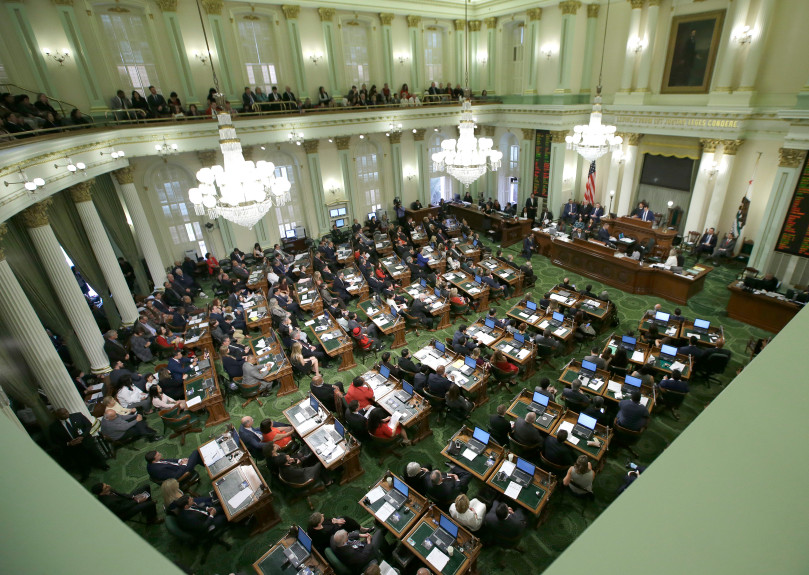
As California lawmakers return to Sacramento on Wednesday, liberal dreams of expanding safety-net benefits and providing health coverage to immigrants are giving way to a new vision revolving around a feverish push to protect gains racked up in the past. After years of pushing forward a progressive agenda, legislative Democrats will be pushing back against conservative policies from President-elect Donald Trump and the Republican Congress. Instead of expanding Medi-Cal health coverage to adult immigrants who can’t prove they’re legally in the country, Democrats are now concentrating on how to retain health coverage for those who already have it. And anti-poverty groups are focused on preventing cuts to food stamp and welfare programs rather than trying to expand them as planned. “There is so much uncertainty at the federal level, because they’re talking about some really drastic policy choices that could have a really negative impact on California,” said Scott Graves, research director for the California Budget & Policy Center, a left-leaning research group. Last year was a particularly effective one for California liberals. The Legislature extended the nation’s most ambitious climate change programs, raised the minimum wage to $15 and toughened gun laws. Lawmakers boosted overtime for farmworkers, expanded welfare benefits and enacted a sweeping array of anti-tobacco measures. This year had all the makings of continuing the trend. Democrats will arrive Wednesday with supermajorities in both chambers – enough to advance their own agenda without GOP interference if they stand united. Notably, though, Democrats took their first action as a supermajority not to advance a contentious public policy objective but to send a message to Trump. Right after they took the oath of office last month, Democrats in the Assembly and Senate suspended legislative rules to immediately approve resolutions urging the incoming administration to keep a program allowing hundreds of thousands of young immigrants who are in the country illegally to stay. While the California Legislature has broad authority to chart its own agenda, it relies significantly on federal dollars. According to the state Department of Finance, California gets $96 billion from the federal government, a figure almost as large as the state’s $122 billion general fund. Those federal funds cover a massive share of the budget for health care, food stamps, welfare and other safety-net programs. Liberals are particularly worried that the budget prepared by U.S. House Speaker Paul Ryan, R-Wisconsin, will lead to severe cuts in those programs through block grants or other methods of shifting responsibility to states, while also giving them more flexibility. “Block granting … is just not what’s in the best interests of the recipients of those programs,” said Sen. Holly Mitchell, a Los Angeles Democrat who will lead the state budget committee next year. “We’re dealing with hungry people, which we cannot ignore.” Graves noted that before the election, he hoped the Legislature would take a serious look at boosting subsidized child care and Supplemental Security Income payments for seniors and people with disabilities. That seems less likely now. Congressional Republicans also are eager to repeal President Barack Obama‘s health care overhaul, which provides $20 billion for the Medi-Cal program and private insurance subsidies. Preserving that coverage, much less expanding it to cover more people, would be extremely expensive. The California Endowment has provided millions of dollars for an advocacy campaign called Health4All to expand Medi-Cal coverage for immigrants who can’t prove they’re legally in the United States. In December, it announced a new initiative: Fight4All. The $25 million effort reflects a shift in focus from creating new rights to defending existing ones. “A whole host of areas where significant progress has been made in California in the last five or six years or so, we feel that work is now in jeopardy,” said Dr. Tony Iton, the endowment’s senior vice president. Still, conservatives in the state aren’t optimistic that Trump’s presidency will give them a reprieve from lawmakers’ persistent push to the left. California’s Legislature is “sort of like its own nation-state,” said Tom Scott, California director of the National Federation of Independent Business, a small-business advocacy organization that often is at odds with legislative priorities including labor and environmental mandates. “Quite frankly, whatever the Trump administration does, it will not stop Gov. Brown and the state Legislature from moving forward on their political agenda,” Scott said. “So I’m on one level expecting sort of business – or un-business – as usual, and I don’t see that changing.” Republished with permission of the Associated Press.
Alabama has one of the fastest growing counties for Hispanics in the U.S., research shows

America’s fastest growing Hispanic populations are not in places one would expect — Florida, California, or Texas. It’s in rural states like Alabama and North Dakota. Alabama’s Russell County had a 92 percent Latino population growth rate between 2007 and 2014, according to a new survey by the Pew Research Center. That makes it fourth in the nation, behind three counties in North Dakota. Russell County is on the eastern border of central Alabama and Georgia, just south of Columbus. Williams County, in northwestern North Dakota, led the pack with a 367 percent increase, followed by Stark County, also in North Dakota, with 294 percent. The Washington Post reports on the study, which shows the largest growth of Hispanic populations in the United States is in a “handful of rural counties far from metropolitan areas dominated by Latinos.” This demographic shift could soon start reshaping the political landscape in mostly rural states; a move Democrats are already beginning to embrace. Acknowledging this population change, Hillary Clinton’s campaign has brought in Hispanic outreach directors for Georgia, Pennsylvania, and North Carolina, making it the first time a presidential campaign has focused its Latino efforts in those areas. Clinton began airing Spanish-language ads this week in Nevada and Florida. Another finding in the study: most Hispanics dispersing throughout the country do not speak Spanish only. As many as 72 percent of Hispanics moving to these fastest-growing counties are identified as “English proficient,” which means they only speak English at home, or speak English along with another language. The national average is 68 percent.
Hillary Clinton raising big dollars at tiny fundraisers

A single elevator could have accommodated the donors who recently gathered with Hillary Clinton at home of the Pritzker family in Chicago’s Gold Coast neighborhood. Small in number, the group was big in largesse, contributing at least $1 million to help elect her and other Democrats this fall. To raise that much money, it would have taken a 37,000-seat stadium of Bernie Sanders fans each chipping in the campaign’s self-described average donation of $27. In her quest for the White House, Clinton is using every fundraising technique at her disposal, including intimate salon-style gatherings with elite donors. Together with small-donor efforts such as email marketing and happy hours for young professionals, these events are helping Clinton collect as much as $1 billion to battle presumptive Republican nominee Donald Trump. The mini-fundraisers have landed big money: At least $19.5 million has flowed from 16 of them over the past two months, according to an Associated Press review. But they also may open her up to criticism. Like her Democratic opponent Sanders, presumptive Republican nominee Donald Trump eagerly depicts Clinton as bought and paid for by her wealthy contributors. “The people who rigged the system are supporting Hillary Clinton because they know as long as she is in charge nothing’s going to change,” Trump told employees of an aluminum scrap metal factory in a speech on Tuesday. And as Clinton works to win over liberals in her party after a divisive primary, the events may undercut her argument that she would be a strong proponent of campaign finance reform. Clinton says Democrats cannot unilaterally disarm in the midst of a tough presidential election, but once in the White House she’d work to reduce big money in politics — a line President Barack Obama also used. Both Clinton and Trump can solicit checks of $350,000 or more from a single donor thanks in part to a Supreme Court ruling that lifted an overall per-person cap on political contributions. That’s roughly triple what the individual donor limit was in 2012. The resulting money flow could help the presidential candidates build robust on-the-ground voter contact and turnout operations, as well as pay for costly advertising. That’s in addition to what’s available on the super PAC side: those groups, which cannot directly coordinate their spending with the candidates, face no contributions limits whatsoever. Clinton has made high-dollar fundraisers a staple of her campaign financing plan, frequently pairing a small pricey event with a far larger one that has a much lower entry fee. It’s a version of what Obama did in 2012, when he held small roundtables with big donors, often just a few blocks from the White House at the Jefferson Hotel. In addition to the 10-person Monday night confab at the home of J.B. and M.K. Pritzker — some of the heirs to the Hyatt hotel fortune — Clinton has held at least nine other events with 15 or fewer donors, according to AP’s review. On Wednesday, the candidate mingled with 15 donors at trendy San Francisco brunch spot Boulettes Larder. Other top-tier fundraisers include a 15-person gathering in late May at the sprawling Portola Valley, California, home of former eBay chief executive John Donahoe, and a double-header two weeks earlier in posh New York City residences. On that date, Clinton scooped up at least $1.5 million for Democratic efforts at financier Steven Rattner‘s home and then headed to longtime friend Lynn Forester de Rothschild‘s place to double the night’s haul. Donors at those events typically were asked to give at least $100,000 to the Hillary Victory Fund. Clinton also has entertained 50 or fewer donors at six more events where the minimum contribution generally was $33,400. The campaigns can accept only $2,700 per donor for each election, but a victory fund allows candidates to ask for more and then parcel out the money to the campaign, national political party and dozens of state parties. Both Trump and Clinton have set up these kinds of accounts. “When a candidate takes that much money, they become dependent on those donors and cannot afford to act against their wishes,” said Josh Silver, director of Represent.us, a group working to reduce the influence of money in politics through state-level public financing measures. “This is exactly why Democrats and Republicans are falling short on the public interest demands of their constituents, and it has a lot to do with the remarkable popularity of Bernie Sanders.” Even while it rakes in big cash, the Clinton campaign has emphasized its efforts to appeal to the kinds of small donors that fueled Sanders’ insurgent candidacy. Clinton’s campaign also has tried to give some small donors big-donor-level access by holding raffles for private dinners with her. The AP was able to conduct its review of Clinton’s fundraisers because her campaign makes public background information about its finance events. Trump’s campaign does not. Trump associates say he has held several small gatherings with bigger donors, including during a May swing through California. Republished with permission of The Associated Press.
Marc Yacht: The voters are angry and unhappy

The late singer Ted Lewis in top hat, cane and tuxedo would look straight at the audience and ask, “Is everybody happy?” He would go on to sing, “Me and My Shadow” or any number of songs in his repertoire. The audience laughed then, but there would be little amusement today. Very few are happy. Democrats and Republicans disagree on most issues, but they are kindred spirits in their distaste for political leadership. According to numerous Pew Research Center polls, Americans have lost confidence in traditional politics. Voters feel betrayed. Republican distaste for Democrats and President Barack Obama runs much deeper than suggested racial bias. The Democratic disdain for Republicans has to do with congressional gridlocks and the GOP’s attitudes about the poor and women’s rights. The popularity of Donald Trump and Bernie Sanders shows the parties’ failure to deliver what voters expected. Republicans and Democrats feel abandoned and are convinced that big money drives the political agenda. They have been lied to and deceived for decades and are right. Now, the birds are coming home to roost. At stake is the future of the two-party system. Trump may hold the key to Republican survival. Sanders’ popularity may not destroy the Democrats but should change their direction and focus. Despite arguments by the Obama administration that the economy is better, the middle and working classes are not seeing this in their wages and lifestyle. What they are seeing is an abuse by corporate executives to fatten their wallets while using lobbying influence to undermine wages. The middle class now feels this pinch. Frontline plant workers have suffered stagnant wages for decades. Many of those workers have been staunch Republicans but cannot ignore inadequate incomes. Furthermore, the future appears bleak. The millionaires, billionaires, corporations and Wall Street are the villains. People believe that generous bonuses were paid to executives with money that was supposed to assist people who were losing their homes. Few were helped. Called “corporate welfare,” the abuses continue. Neither Republicans nor Democrats have digested that betrayal, though each side blames the other. Both sides are to blame. There has been no accountability for the flagrant fiscal abuse. All voters are frightened of terrorism. Recent events in Europe and California perpetrated by extremist Muslims have Americans scared. Irresponsible media pundits are whipping up hate but clearly more is needed in the way of policy than Muslim appeasement. A lack of a sound immigration policy angers voters. Political correctness is thwarting needed action. The public needs to know what is being done to identify Muslim extremist groups to avert further tragedies. Congressional gridlock has angered both sides. People expect Congress to function and many voters are abandoning their party leaders because of the dysfunction. A Gallup poll says that Americans believe that government is to blame for the sluggish economy, lack of jobs and immigration chaos. Politicians are seen as abrogating their responsibility to the people who elected them. The U.S. is losing respect internationally. Americans note that other rich nations see a divided America becoming more estranged from its citizens. Trump and Sanders have tapped into the angry American voter. Both parties may have lost the confidence of their constituents. Once trust is lost, it is very difficult to regain. The parties have neglected their voters for too long. If the Republican leaders are successful and derail Trump, how will Republican voters react? If the Democrat leadership marginalizes Sanders, how will Democratic voters respond? Voters on both sides agree that we need politicians who will serve the public. Most voters feel elected officials have failed them. *** Dr. Marc Yacht, MD, MPH is a retired physician living in Hudson Florida.
Martin Dyckman: Winner-take-all winner could be Trump

Our next president may well owe the office to arrogant billionaires or be one himself. Meanwhile, The New York Times reports that fewer than 400 families account for nearly half the $388-million already invested in that election still more than a year away. Did America shed blood to be rid of monarchy only to have it come to this? And yet the vast moral and political corruption unleashed by the U.S. Supreme Court’s confusion of free spending with free speech is only one of four ways in which government of the people, for the people and by the people has gone off the track. Voting districts in nearly every state are drawn by the party in power to control the outcomes. The elections themselves are monopolized by two increasingly polarized political parties, excluding the increasing numbers of citizens who want nothing to do with either of them. The elections, whether primary or general, can be won with much less than majorities by unpopular candidates who would not be the second choices of most voters. Florida is powerless to control the money. That will take a constitutional amendment or the election of a president who would insist that his or her Supreme Court nominees agree that the Buckley and Citizens United cases were wrongly decided. Florida has made inroads on the gerrymandering through the adoption of the Fair Districts initiatives five years ago and the state Supreme Court’s willingness to enforce them. But that fortunate condition is imperiled by the next four court appointments, which will be controlled by Rick Scott‘s nominating commission. Time is running very short for people who believe in judicial independence to do something about that. The “All Voters Vote” initiative petitions now circulating would break the shared monopoly of the Republicans and Democrats by allowing everyone to vote in an open primary that could nominate two candidates of the same party — or of no party — for state offices and Congress. That’s good for the growing number of voters who claim no party — presently 27 percent — or who identify with the Greens and other minor parties. To that extent, it would be a significant improvement for everyone. Jim Smith, the former Florida secretary of state and a supporter of the initiative, acknowledges that it hasn’t done much to change the lineup of elected officials in Louisiana and California, the other two open-primary states. He is right, however, in saying that it has “changed the conversation — and it’s a conversation that a broader spectrum of voters want to hear candidates talk about.” Republican candidates in districts with sizable Democratic minorities would have to think twice about toeing the Tea Party line. Democratic candidates in safely blue districts would need to court Republican votes for the first time. But “Top Two” is still vulnerable to the winner-take-all weakness. In 1991, a 12-candidate field in Louisiana’s open primary left voters with a dismal runoff choice: former Gov. Edwin Edwards, whose corruption was flagrant, or David Duke, a former Ku Klux Klan grand wizard and an avowed Nazi. There were bumper stickers saying, “Elect the crook — it’s important,” and so the voters did. Edwards went to federal prison in 2002. That same year, 16 candidates sought the French presidency. Nearly everyone assumed there would be a runoff between a conservative, Jacques Chirac, whose ethics were as suspect as Edwards’, and the prime minister, Socialist Lionel Jospin. Chirac ran first, as expected, with 19.8 percent of the vote. But Jospin was edged out of the running by Jean Marie le Pen of the far right National Front, an ultranationalist party. Although nearly two-thirds of the voters had preferred other candidates, their final options were, as in Louisiana, between two obviously unappealing politicians: a suspected crook and a presumed fascist. (Chirac won.) There’s a way to avoid such dismal outcomes. It’s called ranked-choice voting, a task that computer science makes simple. To see how simple — and have some fun — go to this website: www.fairvote.org. There are links on the page to exercises where you can cast rank-ordered votes for political parties and for the Republican and Democratic presidential candidates. Here’s how the presidential game played out for me and for other participants on Monday. In the Republican poll, Donald Trump led the first round, but with only 18 percent. Bobby Jindal ran last and was eliminated. The second-choice votes of his supporters were distributed. There were 15 more rounds, all conducted instantly by computer. Marco Rubio fell out in the 12th and Jeb Bush in the 13th. In the 16th and last round, Trump finally gave way to Rand Paul, who won the nomination with 51.28 percent support. Bernie Sanders led the Democrats with 46 percent. Hillary Clinton ran third, trailing Joe Biden, who isn’t an announced candidate. Martin O’Malley ran last, with 6 percent, and the second choices of his supporters were counted. Clinton was gone in the fourth round. In the sixth and final, Sanders’s support increased to 51.9 percent and he became the nominee. These results are hardly scientific and not necessarily predictive. The samples were small and self-selected. Anyone could vote in either race, and the biases were obviously liberal. But they’re interesting nonetheless. The two “nominees,” Paul and Sanders, project more authenticity than nearly all the others. As for Trump, he piled up more second-choice votes than everyone except Paul. If the Republican Party of Florida still insists on a March 15 winner-take-all primary, which will be well after many of the trailing and financially poorer candidates have dropped out, Trump could easily win it all. Martin Dyckman is a retired associate editor of the St. Petersburg Times. He lives in Western North Carolina.
Daniel Sutter: How to Turn a Drought into a Disaster

California is in the midst of a severe, protracted drought that is producing significant costs and conflicts. The unreported story, however, is how our politicized system of water allocation exacerbates these impacts. The costs of politicized water extend across the nation. Californians are using cell phone cameras and social media to report violators of water use restrictions. Actor Tom Selleck, for instance, was accused of stealing water for his avocados. It turned out that Magnum, P.I., was paying for the water he was taking from a fire hydrant. The main conflict in California pits farmers against other users. Water has many uses beyond watering crops and lawns and filling swimming pools. The computers powering the internet generate lots of heat, and Google uses chilled water to cool its servers. Electricity generation requires considerable water, not just for hydroelectric power, but also when using coal and nuclear power: electricity for a 60 watt lightbulb for a year requires 3,000 to 6,000 gallons of water. Ethanol requires four gallons just to refine one gallon, in addition to growing the corn. Our nation’s water problems, including the conflict news stories describe, result in large part from a failure to use property rights, voluntary exchange, and prices to allocate water. California’s drought is Mother Nature’s doing, but the economic costs and political conflict are largely on us. Farmers have water rights, but not full property rights. They can divert water but only to use it for irrigation. Farmers’ rights to use water can be suspended if river levels fall too low, as determined by bureaucrats. Without water for irrigation, farmers’ crops will fail. Farmers cannot trade (sell) water that they could use for irrigation to Tom Selleck for his avocados or Google for their server farms. A bureaucrat decides what happens to the water, and the result is conflict. Competition for water results because resources are scarce. Scarcity means that our wants and desires exceed our ability to produce goods and services. Economists often praise markets and prices for directing scarce resources to their most highly valued uses, which we call efficiency. Although markets cannot eliminate scarcity, they structure interaction to focus on cooperation and minimize conflict. Consider how the allocation of water contrasts with homes. California is home to some of the nation’s priciest communities, including Malibu on the Pacific Ocean. Homes in Malibu are in great demand, but can be bought and sold. Actor Jeff Bridges recently listed his estate for $29 million, to effectively let someone else get to live in Malibu. But Mr. Bridges will probably be happy if his home sells for the list price, in contrast with the farmers who might lose their water and get nothing in exchange. Such politicized allocation is the norm across the U.S. The city of Troy charges for water, but at a price determined by politicians and not markets. And communities employ orders to reduce water use. Troy currently has a voluntary odd-even lawn watering restriction in place. Such restrictions ramp up when drought conditions worsen, eventually becoming bans. A market approach would raise the price and let people decide if they want to pay perhaps $1,500 a month for a green lawn. We use high prices to clear the market for homes in Malibu, where an 800 square foot beachfront house recently sold for $5 million. I was not a bidder. Our system of politicized water allocation has immense costs, which I will discuss further in the future. The potential exists to use voluntary exchange for water. Economists like Terry Anderson of Montana State University and Nobel Prize winner Vernon Smith have described how rights and markets could work for surface and ground water respectively. Indeed, water market innovations designed by Anderson and his colleagues have improved both economic efficiency and environmental protection. Hopefully a weather pattern change will bring California’s current drought to an end soon. But should the drought continue, remember that much of its pain is from politically self-inflicted wounds. Daniel Sutter is the Charles G. Koch Professor of Economics with the Manuel H. Johnson Center for Political Economy at Troy University and host of Econversations on TrojanVision. Respond to him at dsutter@troy.edu and like the Johnson Center on Facebook.

